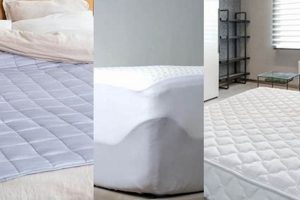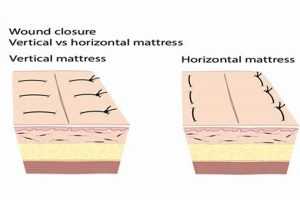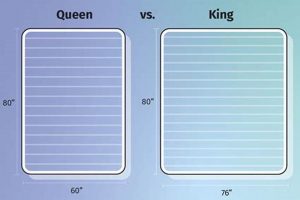The terms relate to the support and surface feel offered by different mattress types. One offers a resilient, unyielding surface, while the other provides a soft, yielding sensation. The choice between the two often depends on individual preferences, sleeping positions, and physical needs. For example, individuals requiring greater spinal alignment might gravitate towards one, whereas those prioritizing pressure relief might favor the other.
Selecting the appropriate sleep surface is crucial for promoting restful sleep and minimizing discomfort. Historically, mattress design focused primarily on durability. However, modern advancements emphasize ergonomic considerations and personalized comfort. The evolution reflects a growing understanding of the relationship between sleep quality and overall well-being. Investing in a suitable mattress can contribute significantly to improved sleep patterns and reduced musculoskeletal strain.
The following sections will delve into the specific characteristics of each type, outlining their advantages and disadvantages, and providing guidance on selecting the optimal option based on individual circumstances. Factors such as body weight, sleeping position, and any existing medical conditions will be discussed to facilitate informed decision-making.
Guidance on Selecting a Mattress
This section offers concise advice to assist in determining the most appropriate mattress type for individual needs.
Tip 1: Assess Spinal Alignment Needs: Individuals requiring significant support for spinal alignment, such as those with back pain, may benefit from the firmer option. The reduced sinkage maintains a more neutral spinal posture.
Tip 2: Consider Sleeping Position: Side sleepers often experience greater pressure on the shoulders and hips. The plusher option can alleviate this pressure, minimizing discomfort during sleep. Back and stomach sleepers generally benefit more from the firmer option.
Tip 3: Evaluate Body Weight: Heavier individuals tend to compress mattresses more significantly. A firmer construction often provides adequate support and prevents excessive sagging. Lighter individuals may find greater comfort on the plusher type.
Tip 4: Account for Partner Preferences: If sharing a bed, consider the sleeping styles and preferences of both individuals. A compromise may involve a mattress with zoned support, offering varying levels of firmness in different areas.
Tip 5: Research Material Properties: Mattresses are constructed from various materials, each offering unique properties. Latex, for example, can offer a resilient feel, while memory foam contours to the body. Understanding these materials is crucial for informed selection.
Tip 6: Prioritize Pressure Relief: Individuals with conditions such as arthritis or fibromyalgia may require enhanced pressure relief. The plusher option generally excels in distributing weight and reducing pressure points.
Tip 7: Test Before Purchasing: Whenever possible, test different mattresses in a showroom setting. Spend at least 10-15 minutes lying on each to accurately assess comfort and support. Consider wearing comfortable clothing during testing.
Tip 8: Inquire About Trial Periods: Many retailers offer trial periods, allowing customers to return a mattress if it proves unsuitable. This provides an opportunity to thoroughly evaluate the mattress in a home environment.
Selecting the correct mattress is a personalized process that necessitates careful consideration of individual needs and preferences. By considering these factors, individuals can increase the likelihood of choosing a mattress that promotes restful sleep and overall well-being.
The subsequent section will explore the long-term implications of choosing a particular sleep surface, including maintenance and potential health considerations.
1. Support
Support, within the context of mattress selection, refers to the capacity of the sleep surface to maintain spinal alignment and distribute body weight evenly. The level of support offered by mattresses varies significantly, particularly between the firmer and plusher varieties. Firmer mattresses generally provide greater resistance to compression, preventing excessive sinking and maintaining a more neutral spinal posture, especially for back and stomach sleepers. Conversely, plush mattresses, due to their softer composition, allow for greater contouring and pressure relief, but may compromise spinal alignment if insufficient underlying support is present. An individual experiencing lower back pain, for example, might find that a mattress lacking adequate support exacerbates their condition, leading to increased discomfort and disrupted sleep. The cause lies in the misalignment of the spine, as the mattress fails to provide the necessary counter-pressure to maintain its natural curvature.
The importance of support as a component stems from its direct impact on musculoskeletal health and sleep quality. Inadequate support can lead to chronic back pain, stiffness, and impaired circulation. Understanding the relationship between support and individual needs is practically significant when selecting a mattress. For instance, a heavier individual will generally require a firmer mattress to ensure adequate support and prevent excessive sagging. Conversely, a lighter individual may find that a plush mattress provides sufficient support while offering enhanced comfort. The selection should, therefore, be based on a comprehensive assessment of factors such as body weight, sleeping position, and any pre-existing musculoskeletal conditions.
In summary, support is a critical determinant of mattress suitability, directly influencing spinal alignment, sleep quality, and overall physical well-being. The challenge lies in accurately assessing individual support needs and selecting a mattress that effectively meets those needs. Considering the aforementioned factors and consulting with healthcare professionals when necessary can mitigate the risk of selecting an inappropriate mattress and promote optimal sleep health.
2. Pressure Relief
Pressure relief, within the context of mattress selection, directly relates to the mattress’s ability to minimize concentrated force on specific areas of the body. This is a critical differentiator. The plusher option generally excels in this area, conforming to the body’s contours and distributing weight more evenly, thereby reducing stress on pressure points such as the shoulders, hips, and knees. The firmer option, while providing more uniform support, often exhibits less contouring, potentially leading to increased pressure on these points. Individuals experiencing arthritis or other conditions characterized by joint pain often find significant relief with a plusher mattress. The root cause of discomfort often lies in the localized compression of tissues and joints, which a more conforming surface can mitigate.
The importance of pressure relief as a component of appropriate mattress selection cannot be overstated. Insufficient pressure relief can lead to disrupted sleep, increased pain, and potentially exacerbate existing medical conditions. For instance, a side sleeper on a too-firm mattress might experience shoulder or hip pain due to the concentrated pressure on these areas. Over time, this can lead to chronic discomfort and impaired sleep quality. Conversely, a back sleeper on a plusher surface might not experience the same level of concentrated pressure, but could potentially sink too deeply, compromising spinal alignment. This underscores the need for a balanced approach that considers both support and pressure relief. Advanced mattress designs often incorporate multiple layers with varying densities to address both needs simultaneously.
In summary, pressure relief is a pivotal factor influencing sleep comfort and overall well-being. While a mattress may offer ample support, inadequate pressure relief can negate these benefits, leading to pain and disrupted sleep. Understanding the relationship between mattress firmness and pressure relief is essential for making informed decisions, particularly for individuals with specific medical conditions or sleeping preferences. The challenge lies in finding a balance between support and pressure relief that optimizes comfort and promotes restful sleep, a balance increasingly achieved through advanced material science and mattress design.
3. Spinal Alignment
Spinal alignment, the proper positioning of the vertebral column, is a fundamental aspect of musculoskeletal health, significantly influenced by the choice between firmer and plusher mattress types. Maintaining natural spinal curvature during sleep is essential for minimizing strain on muscles, ligaments, and intervertebral discs. Mattress selection, therefore, plays a crucial role in promoting or hindering optimal spinal alignment.
- Support and Sagging
A firmer mattress generally offers greater resistance to compression, preventing excessive sagging and maintaining a more neutral spinal posture. Excessive sagging, often associated with plusher mattresses lacking sufficient support, can lead to spinal misalignment, particularly in individuals with higher body weights. This misalignment can contribute to lower back pain, stiffness, and nerve compression.
- Sleeping Position Considerations
The ideal spinal alignment varies depending on sleeping position. Back sleepers typically require a mattress that supports the natural curvature of the lumbar spine. Stomach sleepers often benefit from a firmer mattress to prevent excessive arching of the back. Side sleepers may require a plusher surface to accommodate the shoulders and hips while maintaining spinal alignment. A mattress that fails to account for sleeping position can lead to discomfort and long-term musculoskeletal issues.
- Pressure Point Distribution
Proper spinal alignment necessitates even distribution of pressure along the body. Firmer mattresses may concentrate pressure on specific points, such as the shoulders and hips, while plusher mattresses can better distribute pressure but may compromise overall support. A balanced approach, incorporating both support and pressure relief, is crucial for achieving optimal spinal alignment and minimizing discomfort.
- Long-Term Health Implications
Chronic spinal misalignment can lead to a range of health problems, including chronic pain, muscle fatigue, and nerve damage. Selecting a mattress that promotes proper spinal alignment is a preventative measure, contributing to long-term musculoskeletal health and overall well-being. Individuals with pre-existing spinal conditions should consult with healthcare professionals to determine the most appropriate mattress type.
The interplay between spinal alignment and mattress firmness underscores the importance of personalized selection. While firmer mattresses generally offer greater support and prevent sagging, plusher options may provide enhanced pressure relief. The optimal choice depends on individual factors such as body weight, sleeping position, and any pre-existing spinal conditions. Ultimately, a mattress that effectively supports natural spinal curvature is essential for promoting restful sleep and maintaining musculoskeletal health.
4. Sleeping Position
Sleeping position exerts a significant influence on the suitability of mattress firmness. The relationship stems from variations in pressure distribution across the body depending on whether one sleeps on their back, side, or stomach. These variations dictate differing support and pressure relief requirements, consequently impacting the optimal choice. A back sleeper, for instance, typically requires a mattress that supports the natural curvature of the spine without excessive sinking, promoting even weight distribution. Conversely, a side sleeper concentrates pressure on the shoulders and hips, necessitating a surface that conforms to these areas to alleviate discomfort. Failure to account for the sleeping position when selecting a mattress can result in pain, stiffness, and disrupted sleep patterns.
Consider a scenario involving a side sleeper utilizing a mattress. The concentrated pressure on the shoulder and hip creates localized compression, potentially leading to discomfort and restricted blood flow. A plusher mattress, by conforming to the body’s contours, redistributes this pressure, minimizing stress on these points. However, excessive plushness without adequate underlying support can cause spinal misalignment. Another example involves a stomach sleeper on a too-soft mattress, which can result in an exaggerated arch in the lower back, leading to strain and discomfort. In practical terms, understanding this connection allows individuals to proactively select mattresses that align with their habitual sleeping positions, thereby mitigating potential musculoskeletal issues.
In summary, sleeping position serves as a critical determinant in mattress selection. The interplay between sleeping posture and mattress firmness dictates pressure distribution, spinal alignment, and overall sleep comfort. The challenge lies in identifying ones dominant sleeping position and selecting a mattress that effectively addresses its specific support and pressure relief requirements. A mismatch between sleeping position and mattress firmness can lead to discomfort and potentially exacerbate existing musculoskeletal conditions. Therefore, careful consideration of sleeping position is paramount when evaluating the suitability of mattresses.
5. Body Weight
Body weight exerts a substantial influence on the perceived comfort and support provided by mattresses. The interaction between body mass and mattress firmness dictates the degree of compression experienced during sleep, ultimately affecting spinal alignment and pressure distribution. Individuals with higher body weights exert greater force on the sleep surface, potentially causing excessive sinking in plusher mattresses. This can lead to spinal misalignment, particularly in the lumbar region, resulting in discomfort and potential long-term musculoskeletal issues. Conversely, lighter individuals may not sufficiently compress firmer mattresses, failing to engage the contouring properties necessary for pressure relief. The cause and effect relationship between body weight and mattress performance is, therefore, a critical consideration during mattress selection.
The importance of body weight as a component stems from its direct impact on the load-bearing capacity required of the mattress. For instance, an individual weighing 250 pounds will require a mattress designed to withstand significantly more compressive force than an individual weighing 150 pounds. Selecting a mattress appropriate for one’s body weight ensures adequate support, prevents premature sagging, and promotes proper spinal alignment. A practical example involves an overweight individual consistently experiencing lower back pain on a plush mattress. The root cause may be insufficient support, leading to spinal misalignment. Switching to a firmer mattress can provide the necessary support, alleviating the pain and improving sleep quality. Likewise, a lightweight individual may find a firmer mattress unyielding and uncomfortable, failing to contour to their body shape.
In summary, body weight is a critical factor in determining the suitability of a particular mattress type. Understanding the relationship between body mass and mattress firmness allows for informed selection, promoting optimal spinal alignment, pressure relief, and overall sleep comfort. The challenge lies in accurately assessing individual needs and selecting a mattress with the appropriate support and contouring properties. Failure to consider body weight can lead to discomfort, pain, and potentially long-term health issues. Therefore, a comprehensive assessment of body weight is paramount when evaluating the diverse offerings in the mattress market.
6. Material Density
Material density plays a critical, albeit often overlooked, role in differentiating mattresses. The density of materials directly influences its firmness and plushness. Denser materials, such as high-density memory foam or tightly coiled innersprings, typically contribute to a firmer sleep surface. These materials offer greater resistance to compression, resulting in enhanced support and reduced sinkage. Conversely, less dense materials, like low-density polyurethane foam or loosely packed fiberfill, generally produce a plusher feel. The lesser resistance to compression allows for greater contouring and pressure relief. The causal relationship is straightforward: increased density leads to increased firmness, while decreased density results in increased plushness. Understanding these characteristics is fundamentally important in determining its long-term durability and the initial tactile experience of a mattress.
The importance of material density as a component of the mattresses lies in its direct impact on both comfort and longevity. A high-density foam mattress, for example, will resist sagging and maintain its supportive properties for a longer duration compared to a low-density foam option. This difference has practical implications for individuals seeking a long-term investment. Consider two identical mattresses – one constructed with high-density memory foam and the other with low-density foam. Over time, the latter will likely develop impressions and lose its initial shape, compromising support. In contrast, the former will retain its structural integrity, providing consistent support and comfort. The practical significance of this distinction highlights the value of inquiring about material specifications and density ratings prior to purchase.
In summary, material density serves as a key determinant of mattress firmness and plushness, directly impacting its long-term durability and overall comfort. The challenge lies in discerning the density of materials used in construction, as this information is not always readily available. Understanding this connection allows individuals to make informed decisions, selecting a mattress that aligns with their specific needs and preferences. This requires a shift in focus from marketing claims to factual material specifications, fostering a more discerning approach to mattress selection.
7. Long-Term Durability
Long-term durability, a critical consideration in mattress selection, exhibits a complex relationship with firmness. The longevity of mattresses is influenced by factors such as material density, construction quality, and usage patterns. Firmer mattresses, often constructed with higher-density materials and robust support systems, tend to resist sagging and maintain their structural integrity over extended periods. The inherent resistance to compression inherent to firmer constructions translates directly to enhanced long-term durability. In contrast, plusher mattresses, while offering enhanced initial comfort, are often more susceptible to compression and degradation, potentially resulting in premature sagging and reduced support. The causal link between material composition and mattress lifespan is, therefore, a key determinant of its long-term value.
The importance of long-term durability as a component of mattress selection stems from its direct impact on the overall cost of ownership and sleep quality. Replacing a mattress frequently due to premature wear represents a significant financial burden. Furthermore, a sagging or deteriorated mattress can compromise spinal alignment and pressure distribution, leading to discomfort and disrupted sleep. A practical example involves comparing two mattresses: one a high-density foam mattress and the other a low-density fiberfill mattress. The foam mattress, by resisting compression, can maintain its shape and support for several years, while the fiberfill mattress may develop impressions and lose its cushioning properties within a shorter timeframe. This has practical implications for both consumer budgets and nightly sleep.
In summary, long-term durability is an essential aspect of mattress selection, intricately linked to firmness and material composition. While plusher mattresses may offer superior initial comfort, firmer mattresses often exhibit greater resistance to wear and tear, ensuring long-term support and value. The challenge lies in balancing immediate comfort preferences with the long-term implications of mattress degradation. Consumers should prioritize high-density materials, robust construction, and consider extended warranties to mitigate the risk of premature mattress failure. Ultimately, investing in a durable mattress promotes restful sleep and reduces the financial burden associated with frequent replacements.
Frequently Asked Questions
This section addresses common inquiries regarding the characteristics, benefits, and selection criteria for mattresses. It aims to provide clear, concise information to assist in making informed decisions.
Question 1: What constitutes a “firm” mattress?
A “firm” mattress provides substantial support and minimal surface give. It is typically characterized by high-density materials that resist compression, promoting spinal alignment and reducing sagging.
Question 2: Conversely, what defines a “plush” mattress?
A “plush” mattress offers a softer surface feel and greater contouring. It generally incorporates lower-density materials that readily conform to the body, providing enhanced pressure relief.
Question 3: Which type is generally recommended for back pain?
While individual needs vary, a firmer mattress is often recommended for back pain. The increased support helps maintain spinal alignment, reducing strain on the back muscles and intervertebral discs.
Question 4: Is one type inherently better for side sleepers?
Side sleepers often benefit from a plusher mattress, as it allows the shoulders and hips to sink slightly, reducing pressure points. However, sufficient underlying support is still crucial to prevent spinal misalignment.
Question 5: How does body weight factor into the selection process?
Body weight plays a significant role. Individuals with higher body weights typically require firmer mattresses to prevent excessive sagging, while lighter individuals may find plusher options more comfortable.
Question 6: What are the long-term durability considerations?
Firmer mattresses, often constructed with higher-density materials, generally exhibit greater long-term durability. Plusher mattresses may be more prone to compression and sagging over time, requiring more frequent replacement.
Ultimately, the optimal mattress depends on individual preferences, sleeping position, body weight, and specific health needs. Prioritizing these factors will lead to a more informed and satisfactory purchase.
The subsequent section will offer guidance on cleaning and maintaining mattresses to prolong their lifespan and ensure optimal hygiene.
Conclusion
The preceding analysis has explored various facets of the “firm mattress vs plush” dichotomy, emphasizing the interconnectedness of support, pressure relief, sleeping position, body weight, material density, and long-term durability. A comprehensive understanding of these factors is crucial for informed selection, recognizing that the optimal choice is inherently subjective and contingent upon individual needs and preferences. Failure to consider these aspects may result in compromised sleep quality and potential long-term musculoskeletal issues.
The ultimate decision regarding sleep surface necessitates a thorough self-assessment and, where appropriate, consultation with healthcare professionals. A commitment to prioritizing sleep health, coupled with a discerning approach to mattress selection, represents a proactive investment in overall well-being. Continued research and advancements in sleep science will likely yield further insights, enabling more personalized and effective sleep solutions in the future.







